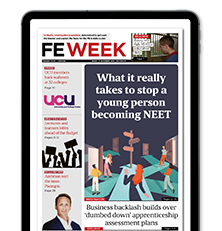We have arrived at the ‘third revolution’ for FE marketing – but colleges will have to make some serious changes, says Lee Parker
With government taking a detailed look at the role and function of FE and with the Covid crisis reshaping our world in every conceivable way, the time is ripe for colleges to rise to the challenge and to recognise that it’s more important than ever to power up their brands.
We are the “good guys” and we have to let our communities know that. With the arrival of T Levels and Institutes of Technology, colleges can occupy a different place in the technical skills market.
Viva la brand revolution!
Over 15 years in FE marketing I’ve seen two fundamental revolutions. First was the emergence of social media from 2008.
From the days of “but should we have a Facebook page – people can comment and others can see it!” to today’s multi-channel engagement strategies, social media allowed us to talk to potential customers directly, without schools or employer gatekeepers barring the way.
The second revolution was the emergence of all the rich content enabled by these platforms. The college prospectus, once the cornerstone of the campaign, is now relegated to a bit part as we develop a suite of case-study videos, live streams, quizzes, interactive microsites and BAFTA-worthy promotional films.
These rapid revolutions have required innovation and improvisation but have been largely a marketing thing.
Brand is inherently strategic. It needs whole organisation buy-in
The next revolution – the third revolution – requires the whole organisation to see marketing as a strategic function, not just a way to reach customers with attractive materials.
Brand is inherently strategic. It needs whole organisation buy-in.
I’ve spent six months researching brand in education for a masters degree and have found that in many colleges, marketing and comms remain outside key decision making.
Too often, the outcome is that brand suffers. In mergers, ambiguity is often sought in the group name – after all, an acronym can’t offend anyone if no one really knows what it stands for.
In doing this, colleges sacrifice hard-earned brand equity, developed over years of existing within and supporting local communities.
Consumers now have never been more brand conscious. We all use brands to create identity, to define what we stand for and develop how we want to be perceived.
Many of us are justly frustrated by the perception of colleges as a second choice, but what exactly are we doing about it?
By not concentrating on developing brand, setting out what makes us unique – our inclusiveness, our openness to embrace new ideas, our community partnerships, the employers we work with and so much more – we’re failing to transform the impression of what FE is and redefining colleges in the public mind.
So, what can be done? A 2006 study by Jon Hulberg showed how promoting the corporate brand rather than products can allow organisations to show how they differ from the competition without just competing on product merits.
This explains why buying something from Harrods feels different, more luxurious, than buying the same product from a high street chain.
If colleges focus on making their brand really aspirational and inspirational, they can stand out from competitors and spend less money promoting individual programmes.
It isn’t easy. Developing a corporate brand strategy requires significant work
If our audiences believe that our core purpose is to use skills to create opportunity and a fairer society, we will be pushing at an open door!
It isn’t easy. Developing a corporate brand strategy requires significant work.
Meanwhile, regular research is essential to ensure that consumers are seeing what a brand is intended to represent.
Most importantly, it’s crucial to focus on a college’s people. Ultimately, if students haven’t bought into the cause, it will lack the authenticity required to deliver the brand strategy.
Brand is the new education marketing revolution. Unlike those that preceded it, it will raise fundamental questions about how colleges operate as commercial enterprises.
If embraced, we can ultimately redefine colleges, allowing them to take their rightful place within the education landscape.








All perfectly true. But brand isn’t something that marketing can control per se.
Why?
Because brand is something that people experience that’s way beyond a logo etc. Brand is what people say about us when our back is turned. It’s what they feel about us and is the intrinsic output of their total experience of us and with us.
Marketing can set the direction and tone of the customer experience but it cannot deliver single handed. Brand is delivered by the organisation when people drive into our car parks, walk though our doors and experience our teaching, estates, wait times on the phone, website, social media and a million other things that is that organisation.
And some of us is beyond a single organisation. The success or failure of a college hundreds of miles away affects the brand perception of all of us. No college is an island!
Some of us have known this for decades. Indeed we have attempted to deliver it in as far as we could. The exemplars were some of the landbased colleges where the relationship between dynamic leaders and marketing was strong.
Oh my goodness, I agree with Stefan, that doesn’t happen too often!
Main issue I have with the branding argument for public services is, to give an example, here in North London, it’s still called Tottenham Tech, even though it’s been *at least* three different names since it was actually that, but none of them have stuck because, at heart, it’s the technical college in Tottenham and that’s all people need to know (no shade on colleagues at Capital City Group here, I think it happens everywhere!)?
All too true Steve. 30 years ago when Barking College came up with a new logo and engagement strategy we found that local people [and by that all the way to Canvey Island] still knew the College as ‘Rush Green College’, even though it had not been called that for many a year. Branding needs to be clear and obvious to the potential user, as the often quoted simple message from Ronseal goes – ‘does what it says on the can’. When I was completing an Ofsted survey on urban colleges several years ago, everyone on one visit just wanted to talk about the very odd name that they were adopting that gave no idea what it was referring to, let alone where it was. Happily they have now reverted to one from the past that tells you exactly what and where they are. My local premiership football club [when I could attend] has a sponsorship message from a local college group that goes round the electronic pitch hoardings and is seen across the globe. A lot of money no doubt has been spent, but no one who sits near me has a clue who the colleges are in the name being put before their eyes. The best form of advertising still remains giving a good experience to your learners so that they recommend you to others, regardless of your wonderful new name, or hopefully, your common sense one.